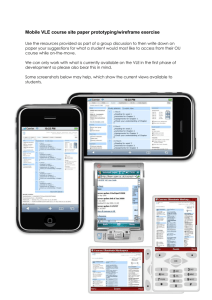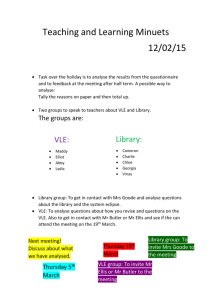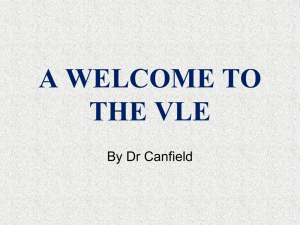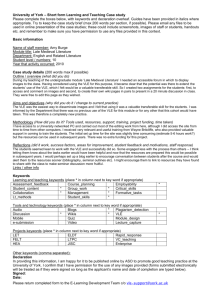Powerpoint Format - John Coliton's Personal Web Site
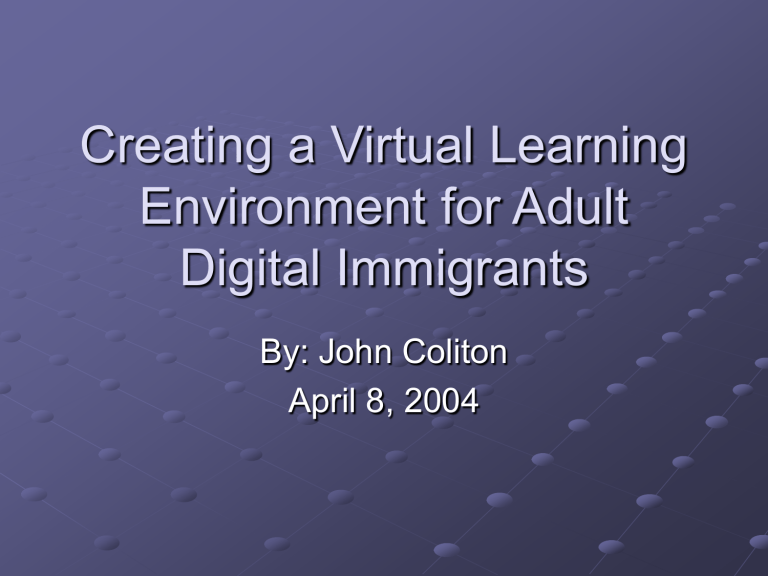
Creating a Virtual Learning
Environment for Adult
Digital Immigrants
By: John Coliton
April 8, 2004
Virtual Learning Environments
A virtual learning environment (VLE) is a designed information space
Educational interactions occur in the environment – turning spaces into places
The information/social space is explicitly represented (from text to 3D)
Students are not only active, but actors – co-constructing the space
Pierre Dillenbrough
– University of Geneva – EUN Conference 2000
Virtual Learning Environments
VLE is not restricted to distance education
VLE integrate heterogeneous technologies and multiple pedagogical approaches
Most VLE overlap with physical environments
Pierre Dillenbrough
– University of Geneva – EUN Conference 2000
Adult Learners
Adult Learners learn differently
Merriam and Caffarella “Learning in
Adulthood”
Knowles “The Adult Learner”
Androgagy vs. Pedagogy
Pedagogy – “the art and science of educating children” (Conner, 2004)
Andragogy – “the art and science of helping adults learn” (Conner)
Andragogy – 5 Key Assumptions
Let learners know why something is important to them
Show learners how to direct themselves through information
Relate the topic to the learner’s experience
Allow learning to occur when learner is ready and motivated to learn
Help learners overcome inhibitions, behaviors and beliefs about learning
Digital Immigrants
Marc Prensky (CEO of Games2Train)
“Today’s students – K through college – represent the first generations to grow up with this new [digital] technology” (the natives)
“Those of us who were not born into the digital world but have, at some later point in our lives, become fascinated by and adopted many or most aspects of the new technology are Digital
Immigrants”
Digital Immigrants
“Digital Immigrant Instructors, who speak an outdated language (that of the pre-digital age), are struggling to teach a population that speaks an entirely new language.” (Prensky)
Before college graduation students today will
Spend over 10,000 hours playing videogames,
read 200,000 emails and instant messages,
Spend 10,000 hours talking on digital cell phones,
Spend over 20,000 hours watching TV,
At the most spend 5,000 reading books
Digital Immigrants
Digital Natives understand and thrive in technological environments
Digital immigrants do not always thrive
Key andragogical concept is scaffolding
(building knowledge based on what the learner already knows)
Many digital immigrants do not have the technological background to build on, and find existing course management sites confusing
Demand for VLE
As a mechanisms for learning anytime/anyplace continue to develop demand will increase
Montgomery College
Fall ’03 had 1,765 students enrolled in distance learning courses (a 110% increase over 1999 enrollment)
Fall ’03 average age of all students – 22, average age of distance learning - 28
Existing VLE
Currently two dominant course management tools are WebCT and
Blackboard.
Current focus is on course management not learning – these systems lack tools for thinking and collaboration (Dr. Curt Bonk,
Indiana University)
Alternatives do exist
Alternative VLE
The Sakai Project – open source sharing of course tools – but almost no interface http://www.sakaiproject.org/
Moodle – another open source project
(utilizing PHP and MySQL) focusing on traditional students http://moodle.org/
Project Overview
To create a VLE that is designed specifically for adult learners without extensive technological backgrounds
Greater demand for VLE as technology develops
Will focus on:
High degree of usability
Ease of Navigation within a course
Tools for interaction between actors
Project Goals
Define what interface elements are required for digital immigrants to successfully navigate/understand the VLE
What navigational cues work best
What communication tools are required
(chats, debate forums, virtual hallways?)
How is content most effectively presented
(online or off, graphically or text, hyperlinked or more traditional flow?)
Project Goals
Define elements that can be directly applied to adult learner needs
How can a digital immigrant scaffold existing knowledge?
Does VLE architecture promote self-directed learning?
Can learner access content/social areas when they are motivated to learn?
Project Goals
Create a model for the interface and information architecture of the system
Implement portions of this model and test for compliance to previous goals
Likely a communication center of some sort
Can be implemented as part of a blended online/on-campus course for testing and evaluation
Additional Information
http://www.emoderators.com
– Distance
Learning Consultants http://learnativity.org/ “Where adult learning, productivity, creativity, and activity meet online” http://mypage.iu.edu/~cjbonk/ - Home page for
Dr. Curt Bonk, links to his papers http://www.socialimpactgames.com
– a list of over 150 games that teach http://www.games2train.com/ - Marc Prensky site for training games
